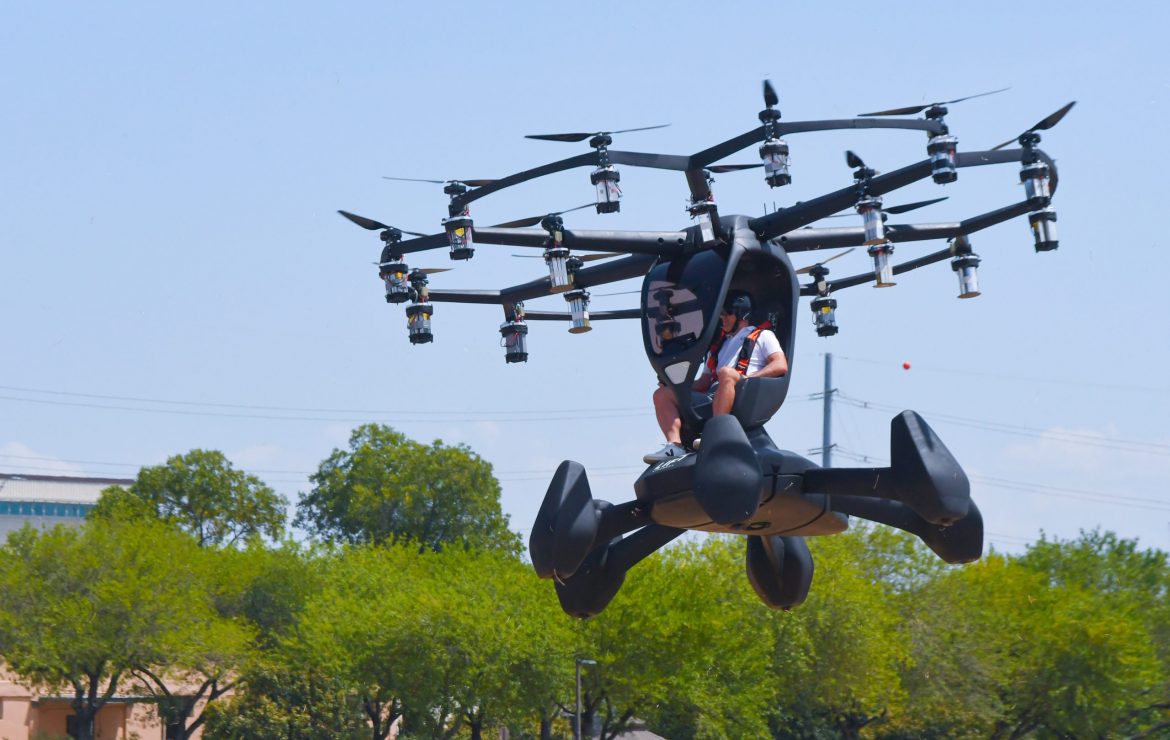The U.S. Air Force began lately testing whether it can use one of the “flying cars” under development for the commercial market for military missions, including rescuing troops, delivering cargo and conducting security checks over an airfield.
Flying cars operate with electricity, take off and land vertically and without a runway, and can be used to transport soldiers or essential supplies, while providing a platform to respond to crises.
Handling Hexa
Last week’s demonstration was accomplished with little fanfare and no significant challenges.
The Hexa aircraft is comprised of an egg-shaped fuselage positioned on four perimeter floats, which allow it to land on water. On top sits a web of 18 electric motors arranged in a hexagonal pattern similar to that of honeycomb.
To package Hexa for transit, Lift Aircraft separated the motors and some additional hardware, and folded down the beams that connect the motors to the aircraft’s fuselage, said Jace McCown, the firm’s flight development engineer and chief pilot.
Once the Hexa was compressed and safely stored with all of its support equipment, Air Force personnel tested out how to load it onto the C-130, eventually choosing to use the aircraft’s ramp system to push it into the cargo bay, said Tech Sgt. Joseph Wruck, who helped support the load tests as part of the 571st Mobility Support Advisory Squadron.
The process of loading the Hexa and support equipment took about 45 minutes, but that timeline could probably be condensed into 15 minutes, Wruck said. And while only one Hexa aircraft was transported during the demonstration, Wruck estimated that a C-130H could carry up to four Hexa platforms, with newer C-130J models potentially able to transport five or six at a time.
Finally, the HC-130J took off, flying the Hexa stored inside its cargo bay from Ohio to Texas.
In the near future, the Air Force will repeat the process as part of Exercise Bushwhacker, when the 355th Wing simulates rescue and attack missions in austere environments.
VTOL platforms with quiet electric engines and simple sustainment footprints could become key to the Air Force as it figures out how to operate away from large airfields, a concept known as agile combat employment, or ACE.
Electric VTOL aircraft capable of landing without a runway could be used to ferry troops and supplies needed to stand up operations, while also providing a platform for crisis response.
During Exercise Bushwhacker, airmen will practice transporting, unloading and reassembling the Hexa — a process that should take about two to three hours, according to McCown.
From there, Hexa will be put through its paces in a number of scenarios, such as delivering supplies or rescuing a stranded troop on the ground, said Maj. Brennan Gallagher, 563rd Rescue Group’s chief of weapons and tactics and the lead planner for 355th Wing’s Agility Prime integration.
Right now, Hexa’s abilities are limited and geared toward the commercial recreation market. The aircraft has room for one person and can fly for about 10-15 minutes, depending on the payload. A person can learn to fly Hexa quickly because many of the flight systems are automated, but Lift plans to develop a fully automated version, McCown said.
In the future, the platform could potentially serve as an armed overwatch aircraft to protect ground troops.
However, there are still missions that the aircraft could be suited for in its current configuration. For instance, while Hexa can’t carry as much weight as required to satisfy certain logistics missions, it could transfer smaller cargo or serve as a vehicle that allows security forces to assess the status of an airfield.
By being involved in the development of eVTOL platforms at an early stage, the Air Force hopes to steer the evolution of the technology into a form that it can use.












